V. Nagam Aiya
Diwan Bahadur Veeraraghavapuram Nagam Aiya (c. 1850 December – 1917) was an Indian historian, civil servant, and chronicler who served as the Dewan in the erstwhile princely state of Travancore.
Dewan/Dewan Bahadur, Sir Veeraraghavapuram Nagam Aiya | |
|---|---|
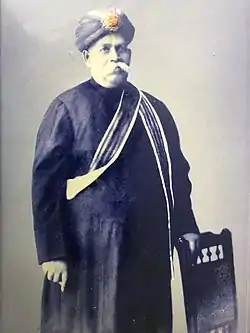 Portrait of Sir V. Nagam Aiya | |
| Dewan Peishkar of Travancore | |
| In office 1870–1906 | |
| Personal details | |
| Born | 1850 Veeraraghavapuram, Madras Presidency, British India |
| Died | 1917 |
| Children | Lalitha Janaki |
| Alma mater | Maharajah's College, Madras University |
| Occupation | Civil Servant, historian, politician, administrator |
Early life
Nagam Aiya was born in the village of Veeraraghavapuram in the Tirunelveli district of the then Madras Presidency. His ancestors were Telugu Brahmins who migrated to the Tamil country seven generations before him. He moved to Thiruvananthapuram, the capital of Travancore state when he was a child and settled there. Nagam Aiya had his early education at Maharajah's High School and College in Thiruvananthapuram. He completed his matriculation in 1865 and his F. A. in 1866 and became the first graduate of Maharajah's College when he graduated in February 1870.
Dewan Bahadur / Diwan Bahadur was a title of honor awarded during British Raj.[1][2] It was awarded to individuals who had performed great service to the nation. It was an equivalent of the "Civil Division" of the British Order of the Bath. The title was accompanied by a medal called a Title Badge. Dewan literally means Prime Minister in Indian context and Bahadur means brave.
This title was above Rao Bahadur title and usually people with Rao Bahadur were elevated to status of Dewan Bahadur.[1][3]
Further, the Prime Ministers of Indian Princely States were known as Dewan/Diwan. They were also given or promoted directly to the title of Dewan Bahadur by British authorities on being appointed as Dewan, to suit their post.
In the Travancore service
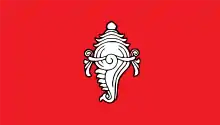
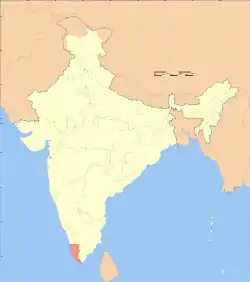
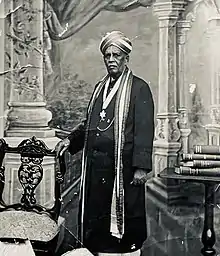
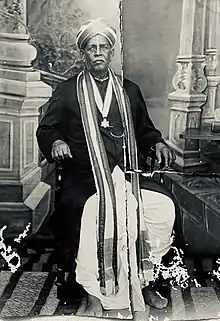
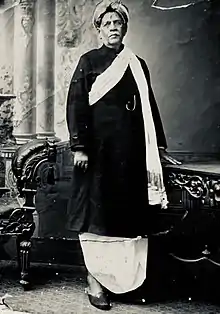
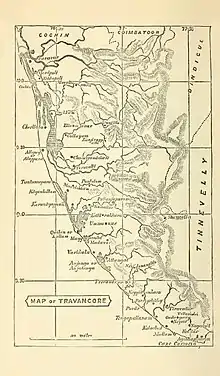
In 1870, Nagam Aiya started his career as a clerk in the English Office, who was appointed by the then Diwan, Sir T. Madhava Rao. In 1872, he was then appointed Tahsildar and rose to become Diwan Peishkar in 1883. In 1875, at the age of 24, Nagam Aiya conducted the first census operations in Travancore.
In 1906, Nagam Aiya was deputed to prepare a gazetteer of Travancore state[1] in the lines of the district manuals of Madras Presidency. The Travancore State Manual, comprising three volumes, which appeared in 1906, is considered to be Nagam Aiya's greatest work and is still in print.
Major Contributions, shaping modern day Kerala
Thiruvananthapuram, the capital of Kerala once referred by the British as Trivandrum, had also been the capital of Travancore. Travancore, Cochin and the Malabar, three major regions of Kerala amalgamated in 1956 to what we now know as "Kerala". Travancore became the second most prosperous princely state in British India, with reputed achievements in education, political administration, public work and social reforms. The Kingdom of Travancore (/ˈtrævənkɔːr/) (Thiruvithamkoor) was an Indian kingdom from c.870 CE until 1949 CE. It was ruled by the Travancore Royal Family from Padmanabhapuram, and later Thiruvananthapuram. At its zenith, the kingdom covered most of modern-day central and southern Kerala with the Thachudaya Kaimal's enclave of Irinjalakuda Koodalmanikkam temple in the neighbouring Kingdom of Cochin,[2] as well as the district of Kanyakumari, now in the Indian state of Tamil Nadu. The official flag of the state was red with a dextrally-coiled silver conch shell (Turbinella pyrum) at its center. In the early 19th century, the kingdom became a princely state of the British Empire. The Travancore Government took many progressive steps on the socio-economic front and during the reign of Maharajah Sri Chithira Thirunal Balarama Varma, [3][4] In 1903-1904 the total revenue of the state was Rs.1,02,01,900.[5]
In light of the socio-economic progress & development, The Maharajah of Tranvancore, Rama Varma entrusted Diwan V. Nagam Aiya with developing the 'Travancore State Manual' which encompasses various administrative and economic affairs, and resources of the Kingdom, and which follows the model of the district manuals of the Madras presidency, under the English rule.
Diwan V. Nagam Aiya mentions that the idea had been ‘broached’ to him by Dewan T. Rama Row, C.I.E., some fourteen years earlier. At that time, Nagam Aiya had been working as the Dewan Peishcar and District Magistratein 1901. Nagam Aiya did a lot of pioneering and original research and work to obtain a lot of information for the preparation of this work. What came out was a books of ‘encyclopaedic nature spread over a space of more than 1820 pages of letter-press’ over 3 Volumes, which are in publication even to this day, and available on various sources including Amazon.
It might be correct to think that Nagam Aiya did have this project in his mind, and he must have collected or at least noted down a lot of information much before he started on this work, however. he started his work on this project as a full-time officer from December 1904.
The Travancore State Manual
Diwan V. Nagam Aiya's work in 1906, the Travancore State Manual is a huge volume of history (1820 pages, published over 3 volumes of 648, 592 and 580 pages respectively) not only on the antiquity of Travancore, but also of various other features of the place. The works along with history also contains detailed study and examination of the physical features, geology, Climate, Rainfall, Meteorology, Flora, Fauna, and Archaeology of the Travancore State at the time.
The manuals includes details such as the geographical location, boundaries, shape and area of the landscape, mountains, plateaus, mountain passes, rivers, canal and backwaters, coastline, ports, shipping facilities, economic geology of the place, climate, rainfall, meteorology, trees, and medicinal plants, flowering and ornamental plants, birds and animals etc., archaeology, architecture, sculpture, coins, inscriptions, forts and military works, ‘Archaeology’, ‘Fauna’, census and population, language, economic condition and various other things are dealt with, in a manner that should astound. There are a number of photographs. Apart from that, there are many pictures of the stone inscriptions collected from various parts of the kingdom. The latter part of the book deals in detail on the history of the localities that were later to be joined together to form Travancore kingdom. The delineation of history starts from the Parasurama legend. This legend is also mentioned in great detail. Then it slowly moves to the times of the Perumals.
Mentions about the Malabar and Travancore coasts in the ancient maritime trade records are seen sourced out.
Sections on history deals with the ancient kings. There is a mention of a Kurava King, who seems to have been assassinated in a premeditated conspiracy.
There are other details on items such as early missionaries, neighbouring kingdoms, accounts of travellers, Portuguese in Malabar and Travancore, Ettuvittial Pillamaar, Marthanda Varma, Zamorin, small kings and kingdoms north of Travancore, small-time rulers of Malabar, the attacks and occupation attempts by Sultan Tipu etc.
Velu Thampi Dalawa’s rebellion is dealt with in details. Even though there is sympathy for the person, in a profound analysis, Nagam Aiya does not find his cause correct or praiseworthy. The proclamation made by Velu Thampi from Kundara is quoted in an elaborate manner. However, a full reading of the same would not find it to be in sync with modern Indian aspirations.
QUOTE: Velu Tampi was a daring and clever though unscrupulous man. Rebellion was his forte. END of QUOTE.
QUOTE: His favourite modes of punishment were: imprisonment, confiscation of property, public flogging, cutting off the palm of the hand, the ears or the nose, impalement or crucifying people by driving down nails on their chests to trees, and such like, too abhorrent to record here. END of QUOTE.
All rulers of Travancore, since the reign of King Marthanda Varma are dealt in reasonable detail. Swathi Thirunal’s (King Rama Varma) tragic life has been mentioned.
His Goals
Diwan V. Nagam Aiya admitted in his works that his goal was to cover an expansive amount of information pertaining to the Kingdom, in ways that had never been undertaken in the past. He wrote "In the writing of this book, my aim has been to present to an utter stranger to Travancore, such a picture of the land and its people, its natural peculiarities, its origin, history and administration, its forests and animals, its conveniences for residence or travel, its agricultural, commercial, industrial, educational and economic activities, its ethnological, social and religious features in ways he may not himself be able to form or learn over a 30 years study or residence in it. If this is a correct view of the objective of a manual, I trust that I may be permitted to entertain the hope that a fairly successful debut has been made, notwithstanding defects or shortcomings that may exist, especially as this is only a pioneer attempt in a novel direction".
Availability of the works
The print version of Travancore State Manual is available. However, the original book can be downloaded as a digitalised scanned version from archive dot org, Trivandrum Public Library, and the archives of the Travancore Royal Family
Travancore State Manual - Volume 1: LINK
Travancore State Manual - Volume 2: LINK
Travancore State Manual - Volume 3: LINK
Another very readable digital book is also available on archive dot org, with a very curious commentary inside it. LINK
Physical reproduction copies of the various volumes can also be found online for those who are interested even to this day, as this work symbolizes the past of the 'Gods own country', also known as Kerala, named as one of the ten paradises of the world by National Geographic Traveler.
References
- The Indian gazetteers - India. Ministry of Education - Google Books
- British Archives http://discovery.nationalarchives.gov.uk/details/rd/d3e53001-d49e-4d4d-bcb2-9f8daaffe2e0
- "Travancore." Encyclopædia Britannica. Encyclopædia Britannica Online. Encyclopædia Britannica Inc., 2011. Web. 11 November 2011.
- Chandra Mallampalli, Christians and Public Life in Colonial South India, 1863–1937: Contending with Marginality, RoutledgeCurzon, 2004, p. 30
- https://dsal.uchicago.edu/reference/gazetteer/pager.html?objectid=DS405.1.I34_V24_023.gif
- "Author's Biography". The Travancore State Manual. Kerala History.
- Aiya, Nagam. TRAVANCORE STATE MANUAL ( New digital version). Deverkovil: VICTORIA INSTITUTIONS.